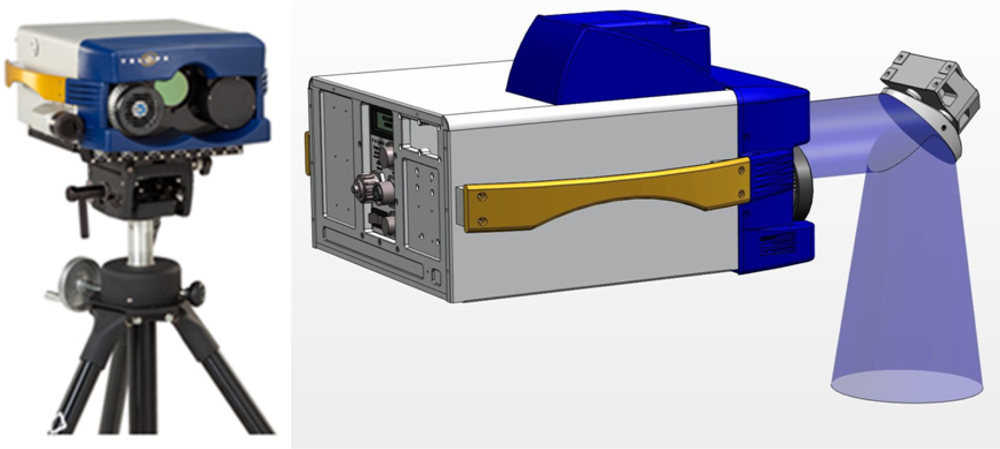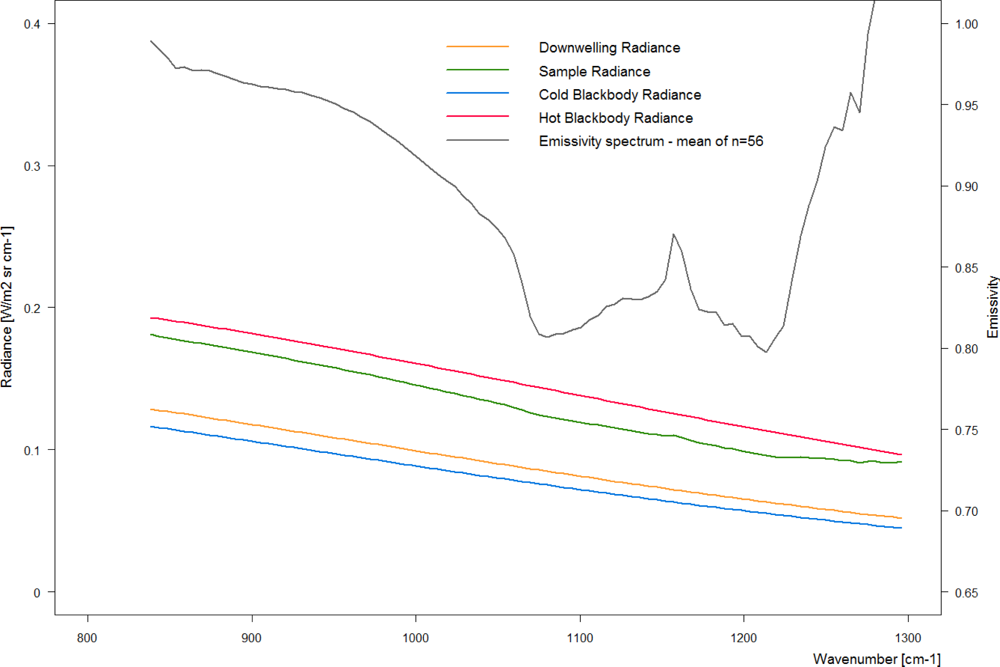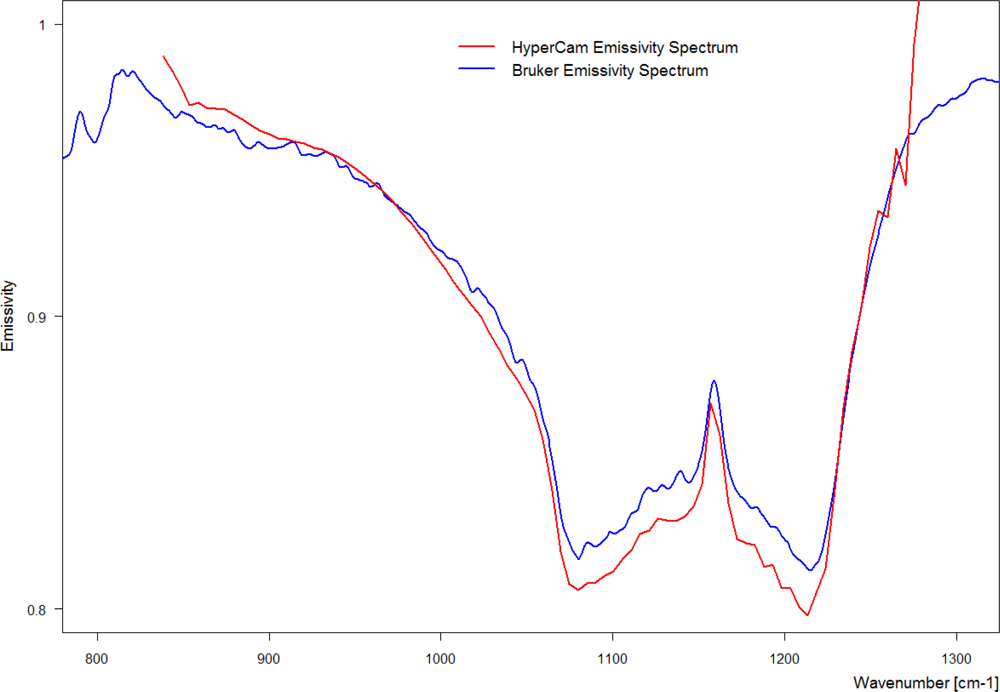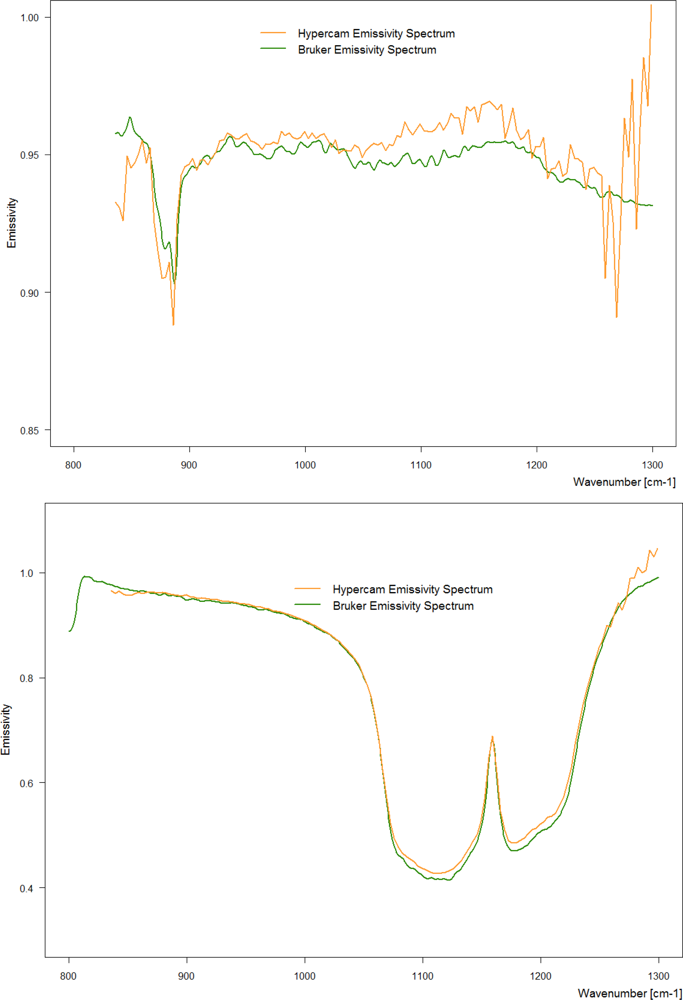A Hyperspectral Thermal Infrared Imaging Instrument for Natural Resources Applications
Abstract
:1. Introduction
2. Instrument Setup
2.1. Base Instrument
2.2. Modifications: Customized Mirror System, Setup for Vertical Measurements
2.3. Airborne Module
3. Measurement Procedures
3.1. Instrument Preparation and Settings
3.2. Sample Preparation
3.3. Instrument Calibration
3.4. Background Radiation
3.5. Emissivity Calculation
3.6. Testing Repeatability
3.7. Comparison with Reference Spectra
4. Results and Discussion
4.1. Repeatability
4.2. Comparison of Emissivity Spectra with Reference Spectra
4.3. Spatial Variability of Emissivity
5. Conclusions and Outlook
Acknowledgments
References
- Jensen, J.R. Remote Sensing of the Environment: An Earth Resource Perspective, 2nd ed.; Pearson Prentice Hall: Upper Saddle River, NJ, USA, 2007; p. 592. [Google Scholar]
- Eisele, A.; Lau, I.; Hewson, R.; Carter, D.; Wheaton, B.; Ong, C.; Cudahy, T.J.; Chabrillat, S.; Kaufmann, H. Applicability of the thermal infrared spectral region for the prediction of soil properties across semi-arid agricultural landscapes. Remote Sens 2012, 4, 3265–3286. [Google Scholar]
- Frey, C.M.; Parlow, E. Flux measurements in Cairo. Part 2: On the determination of the spatial radiation and energy balance using ASTER satellite data. Remote Sens 2012, 4, 2635–2660. [Google Scholar]
- Ogashawara, I.; Bastos, V.S.B. A quantitative approach for analysing the relationship between urban heat islands and land cover. Remote Sens 2012, 4, 3596–3618. [Google Scholar]
- Carter, A.; Ramsey, M. Long-term volcanic activity at Shiveluch Volcano: Nine years of ASTER spaceborne thermal infrared observations. Remote Sens 2010, 2, 2571–2583. [Google Scholar]
- Vollmer, M; Möllmann, K.-P. Infrared Thermal Imaging: Fundamentals, Research and Applications; Wiley-VCH: Weinheim, Germany, 2010. [Google Scholar]
- Schott, J.; Gerace, A.; Brown, S.; Gartley, M.; Montanaro, M.; Reurer, D.C. Simulation of image performance characteristics of the Landsat Data Continuity Mission (LDCM) Thermal Infrared Sensor (TIRS). Remote Sens 2012, 4, 2477–2491. [Google Scholar]
- Christensen, P.R.; Bandfield, J.L.; Hamilton, V.E.; Ruff, S.W.; Kieffer, H.H.; Titus, T.N.; Greenfield, M. Mars global surveyor thermal emission spectrometer experiment: Investigation description and surface science results. J. Geophys. Res 2001. [Google Scholar] [CrossRef]
- Lucey, P.G.; Williams, T.J.; Hinrichs, J.L.; Winter, M.E.; Steutel, D.; Winter, E.M. Three years of operation of AHI: The University of Hawaii’s airborne hyperspectral imager. Proc. SPIE 2001. [Google Scholar] [CrossRef]
- Hackwell, J.A.; Warren, D.W.; Bongiovi, R.P.; Hansel, S.J.; Hayhurst, T.L.; Mabry, D.J.; Sivjee, M.G.; Skinner, J.W. LWIR/MWIR imaging hyperspectral sensor for airborne and ground-based remote sensing. Proc. SPIE 1996, 2819, 102–107. [Google Scholar]
- Lagueux, P.; Farley, V.; Rolland, M.; Chamberland, M.; Puckrin, E.; Turcotte, C.S.; Lahaie, P.; Dube, D. Airborne Measurements in the Infrared Using FTIR-Based Imaging Hyperspectral Sensors. Proceedings of First Workshop on Hyperspectral Image and Signal Processing: Evolution in Remote Sensing, Grenoble, France, 26–28 August 2009; pp. 482–485.
- Hirschfeld, T. Wavenumber scale shift in Fourier transform infrared spectrometers due to vignetting. Appl. Spectrosc 1976, 30, 549–550. [Google Scholar]
- Da Luz, B.R.; Crowley, J.K. Identification of plant species by using high spatial and spectral resolution thermal infrared (8.0–13.5 μm) imagery. Remote Sens. Environ 2010, 114, 404–413. [Google Scholar]
- Puckrin, E.; Turcotte, C.S.; Lahaie, P.; Dube, D.; Farley, V.; Lagueux, P.; Marcotte, F.; Chamberland, M. Airborne infrared-hyperspectral mapping for detection of gaseous and solid targets. Proc. SPIE 2012. [Google Scholar] [CrossRef]
- Vaughan, R.G.; Calvin, W.M.; Taranik, J.V. SEBASS hyperspectral thermal infrared data: Surface emissivity measurement and mineral mapping. Remote Sens. Environ 2003, 85, 48–63. [Google Scholar]
- Gillespie, A.; Rokugawa, S.; Matsunaga, T.; Cothern, J.S.; Hook, S.; Kahle, A.B. A temperature and emissivity separation algorithm for Advanced Spaceborne Thermal Emission and Reflection Radiometer (ASTER) images. IEEE Trans. Geosci. Remote Sens 1998, 36, 1113–1126. [Google Scholar]
- Hook, S.J.; Kahle, A.B. The micro Fourier Transform Interferometer (mu FTIR)—A new field spectrometer for acquisition of infrared data of natural surfaces. Remote Sens. Environ 1996, 56, 172–181. [Google Scholar]
- French, A.N.; Schmugge, T.J.; Ritchie, J.C.; Hsu, A.; Jacob, F.; Ogawa, K. Detecting land cover change at the Jornada Experimental Range, New Mexico with ASTER emissivities. Remote Sens. Environ 2008, 112, 1730–1748. [Google Scholar]
- Da Luz, B.R.; Crowley, J.K. Spectral reflectance and emissivity features of broad leaf plants: Prospects for remote sensing in the thermal infrared (8.0–14.0 μm). Remote Sens. Environ 2007, 109, 393–405. [Google Scholar]
- Hecker, C.; Hook, S.; van der Meijde, M.; Bakker, W.; van der Werff, H.; Wilbrink, H.; van Ruitenbeek, F.; de Smeth, B.; van der Meer, F. Thermal infrared spectrometer for earth science remote sensing applications-instrument modifications and measurement procedures. Sensors 2011, 11, 10981–10999. [Google Scholar]
- Salisbury, J.; Walter, L.; Vergo, N.; D’Aria, D. Infrared (2.1–25 Micrometers) Spectra of Minerals; The Johns Hopkins University Press: Baltimore, MD, USA, 1992. [Google Scholar]
- Ullah, S.; Schlerf, M.; Skidmore, A.K.; Hecker, C.A. Identifying plant species using mid-wave infrared, 2.5–6 μm, and thermal infrared, 8–14 μm, emissivity spectra. Remote Sens. Environ 2012, 118, 95–102. [Google Scholar]
- Balick, L.; Gillespie, A.; French, A.; Danilina, I.; Allard, J.P.; Mushkin, A. Longwave thermal infrared spectral variability in individual rocks. IEEE Geosci. Remote Sens. Lett 2009, 6, 52–56. [Google Scholar]
- Korb, A.R.; Dybwad, P.; Wadsworth, W.; Salisbury, J.W. Portable Fourier transform infrared spectroradiometer for field measurements of radiance and emissivity. Appl. Opt 1996, 35, 1679–1692. [Google Scholar]
- Kealy, P.S.; Hook, S.J. Separating temperature and emissivity in thermal infrared multispectral scanner data: Implications for recovery of land surface temperatures. IEEE Trans. Geosci. Remote Sens 1993, 31, 1155–1164. [Google Scholar]
- Horton, K.A.; Johnson, J.R.; Lucey, P.G. Infrared measurements of pristine and disturbed soils 2. Environmental effects and field data reduction. Remote Sens. Environ 1998, 64, 47–52. [Google Scholar]
- Salisbury, J.W.; Wald, A.; D’Aria, D.M. Thermal-infrared remote sensing and Kirchhoff’s law: 1. Laboratory measurements. J. Geophys. Res 1994, 99, 897–911. [Google Scholar]
- Rockwell, B.W.; Hofstra, A.H. Identification of quartz and carbonate minerals across northern Nevada using ASTER thermal infrared emissivity data—Implications for geologic mapping and mineral resource investigations in well-studied and frontier areas. Geosphere 2008, 4, 218–246. [Google Scholar]
- Jimenez-Munoz, J.C.; Sobrino, J.A.; Gillespie, A.R. Surface emissivity retrieval from airborne hyperspectral scanner data: Insights on atmospheric correction and noise removal. IEEE Geosci. Remote Sens. Lett 2012, 9, 180–184. [Google Scholar]
- Roberts, D.A.; Quattrochi, D.A.; Hulley, G.C.; Hook, S.J.; Green, R.O. Synergies between VSWIR and TIR data for the urban environment: An evaluation of the potential for the Hyperspectral Infrared Imager (HyspIRI) Decadal Survey mission. Remote Sens. Environ 2012, 117, 83–101. [Google Scholar]







| Parameter | Unit | Hyper-Cam-LW |
|---|---|---|
| Spectral Range | μm | 7.7–12 |
| Spectral Resolution | cm−1 | 0.25 to 150 (user adjustable) |
| Image Format | - | 320 × 256 pixels |
| Field of View | Degrees | 6.4 × 5.1 (nominal) |
| Degrees | 25.6 × 20.4 (0.25× telescope) | |
| Typical NESR | nW/cm2·srcm−1 | <20 |
| Radiometric Accuracy | K | <1 |
Share and Cite
Schlerf, M.; Rock, G.; Lagueux, P.; Ronellenfitsch, F.; Gerhards, M.; Hoffmann, L.; Udelhoven, T. A Hyperspectral Thermal Infrared Imaging Instrument for Natural Resources Applications. Remote Sens. 2012, 4, 3995-4009. https://doi.org/10.3390/rs4123995
Schlerf M, Rock G, Lagueux P, Ronellenfitsch F, Gerhards M, Hoffmann L, Udelhoven T. A Hyperspectral Thermal Infrared Imaging Instrument for Natural Resources Applications. Remote Sensing. 2012; 4(12):3995-4009. https://doi.org/10.3390/rs4123995
Chicago/Turabian StyleSchlerf, Martin, Gilles Rock, Philippe Lagueux, Franz Ronellenfitsch, Max Gerhards, Lucien Hoffmann, and Thomas Udelhoven. 2012. "A Hyperspectral Thermal Infrared Imaging Instrument for Natural Resources Applications" Remote Sensing 4, no. 12: 3995-4009. https://doi.org/10.3390/rs4123995
APA StyleSchlerf, M., Rock, G., Lagueux, P., Ronellenfitsch, F., Gerhards, M., Hoffmann, L., & Udelhoven, T. (2012). A Hyperspectral Thermal Infrared Imaging Instrument for Natural Resources Applications. Remote Sensing, 4(12), 3995-4009. https://doi.org/10.3390/rs4123995





